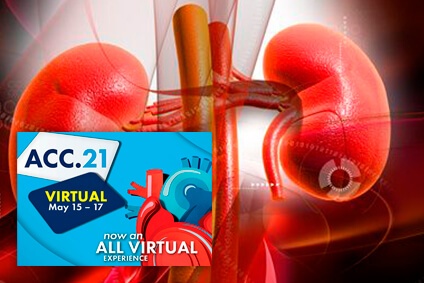Endovascular ultrasound renal denervation significantly reduces systolic blood pressure when compared against a sham procedure according to this new study presented at ACC 2021 simultaneously published in the Lancet.

Renal denervation reduces ambulatory daily systolic blood pressure by 8 mmHg vs 3 mmHg in the sham procedure branch. This translates into a mean 4.5 mmHg reduction, which results significative (p=0.02).
In addition, there was significant reduction to 24 ambulatory systolic blood pressure, as well as office blood pressure.
Even though all patients included in the study had been treated with a combination of at least 3 drugs (one of them a diuretic) their blood pressure readings still remained over 150 mmHg.
After the disappointing outcomes of SYMPLCITY HTN-3, the technique was considerably improved and there are now studies with positive results. The device used in RADIANCE-HTN TRIO is assisted by ultrasound to apply 2 or 3 7-second circumferential applications to the renal artery.
All eligible patients for this study were changed to a fix drug scheme including a calcium beta blocker, an angiotensin inhibitor, and a thiazide diuretic. If after 4 weeks patients continued to present daily hypertension readings over 135/85 mmHg, they were randomized to ultrasound renal denervation vs. the sham procedure.
Read also: ACC 2021 | Sacubitril/Valsartan not Superior to Ramipril after AMI.
989 patients were enrolled, and 69 were finally randomized to denervation and 67 to the sham procedure. This was basically because after 4 weeks researchers were able to reach blood pressure targets.
At 2 months, the active Branch saw a significant reduction of all hypertension variables, including the primary end point of ambulatory daytime blood pressure.
The only adverse event was a femoral access site pseudoaneurysm in the denervation Branch.
RADIANCE-HTN-TRIOOriginal Title: Ultrasound renal denervation for hypertension resistant to a triple medication pill (RADIANCE-HTN TRIO): a randomized, multicenter, single-blind, sham-controlled trial.
Reference: Azizi M et al. Presentado en el congreso de la ACC 2021 y publicado simultáneamente en Lancet 2021; Epub ahead of print. DOI:https://doi.org/10.1016/S0140-6736(21)00788-1.
Subscribe to our weekly newsletter
Get the latest scientific articles on interventional cardiology





